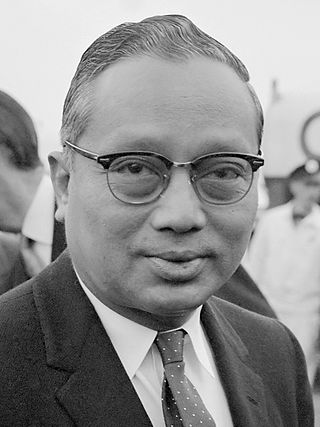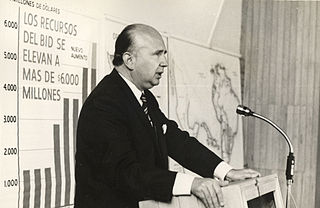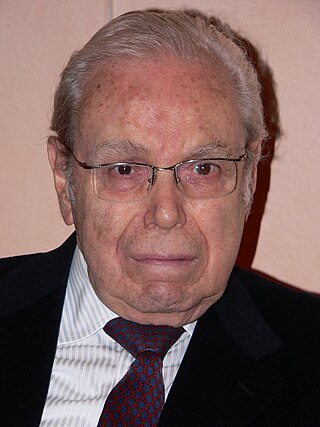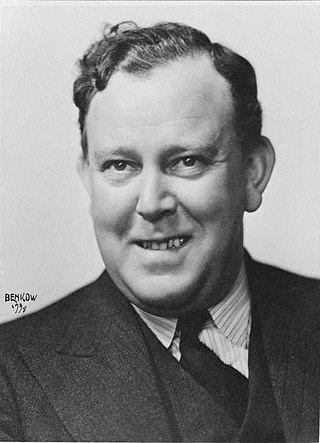Related Research Articles

The secretary-general of the United Nations is the chief administrative officer of the United Nations and head of the United Nations Secretariat, one of the six principal organs of the United Nations.

Boutros Boutros-Ghali was an Egyptian politician and diplomat who served as the sixth Secretary-General of the United Nations from 1992 to 1996. Prior to his appointment as secretary-general, Boutros-Ghali was the acting Minister of Foreign Affairs of Egypt between 1977 and 1979. He oversaw the United Nations over a period coinciding with several world crises, including the breakup of Yugoslavia and the Rwandan genocide.

Dag Hjalmar Agne Carl Hammarskjöld was a Swedish economist and diplomat who served as the second Secretary-General of the United Nations from April 1953 until his death in a plane crash in September 1961. As of 2023, he remains the youngest person to have held the post, having been only 47 years old when he was appointed. He was a son of Hjalmar Hammarskjöld, who served as Prime Minister of Sweden from 1914 to 1917.

Thant, known honorifically as U Thant, was a Burmese diplomat and the third secretary-general of the United Nations from 1961 to 1971, the first non-Scandinavian to hold the position. He held the office for a record 10 years and one month.

The United Nations Security Council veto power is the power of the five permanent members of the UN Security Council to veto any "substantive" resolution. They also happen to be the nuclear-weapon states (NWS) under the terms of the Treaty on the Non-Proliferation of Nuclear Weapons. However, a permanent member's abstention or absence does not prevent a draft resolution from being adopted. This veto power does not apply to "procedural" votes, as determined by the permanent members themselves. A permanent member can also block the selection of a Secretary-General, although a formal veto is unnecessary since the vote is taken behind closed doors.

Salim Ahmed Salim is a Tanzanian politician and diplomat who has worked in the international diplomatic arena since the early 1960s. He served as prime minister for one year 1984–1985.
Chapter V of the United Nations Charter contains provisions establishing the United Nations Security Council.

A United Nations Secretary-General selection was held in 2006 to succeed Kofi Annan, whose second term as Secretary-General of the United Nations ran until 31 December 2006. Seven candidates were officially nominated for the position.

Felipe Herrera Lane was a Chilean economist, lawyer, academic and political socialist. He served as the first president of the Inter-American Development Bank, where he gained a reputation as a "developmentalist."

United Nations Security Council resolution 1090, adopted without a vote at a closed meeting on 13 December 1996, having considered the question of the recommendation for the appointment of the Secretary-General of the United Nations, the Council recommended to the General Assembly that Mr. Kofi Annan be appointed for a term of office from 1 January 1997, to 31 December 2001.

A United Nations Secretary-General selection was held in October 2016 to choose the ninth secretary-general of the United Nations to succeed Ban Ki-moon from 1 January 2017. Six straw polls were held in the Security Council from 21 July 2016 to 5 October 2016. António Guterres of Portugal led the polling in every round, finishing the last round with 13 'encourage' votes, 0 'discourage' votes, and 2 abstentions. On 6 October 2016, the Security Council unanimously recommended Guterres to the General Assembly, which formally selected him by acclamation on 13 October 2016.

A United Nations Secretary-General selection was held in 1996 at the end of Boutros Boutros-Ghali's first term. Boutros-Ghali ran unopposed for a second term and received the support of 14 of the 15 members of the United Nations Security Council. However, the United States vetoed his re-selection and eventually forced him to withdraw his candidacy.

A United Nations Secretary-General selection was held in 1991 to replace Javier Pérez de Cuéllar, whose second term would end on 31 December 1991. Boutros Boutros-Ghali of Egypt was selected for a term ending on 31 December 1996, becoming the first Secretary-General from Africa.

A United Nations Secretary-General selection was held in 1981. Kurt Waldheim ran for an unprecedented third full term as Secretary-General, losing to Salim Ahmed Salim by one vote. However, the selection deadlocked through 16 rounds of voting as China vetoed Waldheim and the United States voted against Salim. The Security Council finally settled on a dark horse candidate who stayed home and did not campaign. Javier Pérez de Cuéllar was selected for a term beginning on 1 January 1982, becoming the first Secretary-General from Latin America.

A United Nations Secretary-General selection was held in 1976 at the end of Kurt Waldheim's first term. After a single symbolic veto from China to show its support for a Secretary-General from the Third World, Waldheim easily defeated Luis Echeverría Álvarez in the balloting. The Security Council re-selected Kurt Waldheim as Secretary General for another five-year term beginning 1 January 1977.

A United Nations Secretary-General selection was held in 1971 to succeed U Thant, who was stepping down after two full terms. Three candidates received enough votes in the Security Council to be selected Secretary-General: Carlos Ortiz de Rozas of Argentina, Kurt Waldheim of Austria, and Max Jakobson of Finland. However, all of the frontrunners were vetoed in the first two rounds of voting. In the third round, Waldheim accidentally escaped a triple-veto when three permanent members failed to coordinate their votes and all abstained. As a result, Kurt Waldheim was selected Secretary-General of the United Nations for a term starting 1 January 1972.

A United Nations Secretary-General selection was held in 1961 to replace Dag Hammarskjöld after he was killed in a plane crash. After initial Soviet attempts to replace the secretary-general with a troika, it was agreed that an acting secretary-general would be appointed for the remainder of Hammarskjöld's term. Within two weeks, U Thant of Burma emerged as the only candidate who was acceptable to both the Soviet Union and the United States. However, the superpowers spent another four weeks arguing over the number of assistant secretaries-general, before finally resolving their dispute by allowing Thant to decide for himself. Thant was then voted in unanimously for a term ending on 10 April 1963.

A United Nations Secretary-General selection was held in 1953 after Trygve Lie announced his intention of resigning. Lie had been at odds with the Soviet Union since the outbreak of the Korean War, and the negotiations for an armistice offered the opportunity for a new Secretary-General to turn the page. The British delegation dragged out the selection process as they campaigned for Lester Pearson of Canada, but he was vetoed by the Soviet Union. Other candidates fell short of a majority in the Security Council. After two weeks of deadlock, France proposed Dag Hammarskjöld of Sweden as a dark horse candidate. Hammarskjöld was acceptable to both superpowers and was selected Secretary-General for a 5-year term.

The United Nations Secretary-General selection of 1950 took place as the Cold War turned hot in the Korean War. The Soviet Union vetoed Trygvie Lie's second term and offered to vote for any other candidate. However, the United States insisted that Lie had to continue in office as Secretary-General, pressuring its allies to abstain on all other candidates. When a Latin American candidate appeared to have enough votes to win, the United States threatened to use its veto for the first time. After a second round of voting with no candidates receiving the required majority, the Security Council informed the General Assembly that it had been unable to agree on a recommendation. The General Assembly then extended Lie's term for three years.

A United Nations Secretary-General selection was held in June 2021 to choose the Secretary-General of the United Nations. Incumbent António Guterres was the only official candidate for the position. On June 8, 2021, Guterres was unanimously recommended by the United Nations Security Council (SC) for a second term at the helm of the organisation. His re-election was ratified by the United Nations General Assembly (GA) by acclamation on June 18, 2021, without a vote. Guterres commenced his second term on 1 January 2022.
References
- ↑ "Portugal's Antonio Guterres elected UN secretary-general". BBC News. 14 October 2016.
- ↑ "Procedure of Selecting and Appointing the next UN Secretary-General". United Nations. 4 January 2016.
- ↑ "A/RES/11(I) Terms of Appointment of the Secretary-General". UN Docs. United Nations.
- ↑ Chesterman, Simon (2007). "Introduction". In Chesterman, Simon (ed.). Secretary or General? The UN Secretary-General in World Politics. Cambridge: Cambridge University Press. p. 7.
- 1 2 3 Sievers, Loraine; Davis, Sam (2014). The Procedure of the UN Security Council (4 ed.). Oxford Univ Press. ISBN 9780199685295.
- 1 2 3 "The 'Wisnumurti Guidelines' for Selecting a Candidate for Secretary-General" (PDF). UNElections.org. Archived from the original (PDF) on 30 March 2016. Retrieved 31 December 2016.
- ↑ "Repertoire of the Practice of the Security Council" (PDF). p. 224.
- 1 2 Sengupta, Somini (21 July 2016). "Secrecy Reigns as U.N. Seeks a New Secretary General". The New York Times.
- ↑ "A Well-Read Secretary General". The New York Times. 13 December 1981.
With a figurative puff of white smoke, the United Nations Security Council finally selected a new Secretary General – a seasoned and soft-spoken diplomat from Peru, Javier Perez de Cuellar.
- ↑ Lynch, Colum. "The Race for U.N. Secretary-General Is Rigged". Foreign Policy.
- ↑ Israelyan, Victor (November 2010). On the Battlefields of the Cold War: A Soviet Ambassador's Confession. Penn State Press. ISBN 9780271047737.
- ↑ "Selecting the UN Secretary-General: Vetoes, Timing and Regional Rotation" (PDF). Security Council Report. 20 September 2015. Retrieved 30 December 2016.
- 1 2 Lewis, Paul (22 November 1991). "Security Council Selects Egyptian for Top U.N. Post". The New York Times.
- 1 2 Crossette, Barbara (13 December 1996). "Ghanaian Gains Ground In Candidacy To Head U.N." The New York Times.
- ↑ Crossette, Barbara (12 December 1996). "In Jockeying to Lead U.N., Ghanaian Is Moving Ahead". The New York Times.
- 1 2 Tharoor, Shashi (21 October 2016). "The inside Story of How I Lost the Race for the UN Secretary-General's Job in 2006". OPEN Magazine.
- 1 2 "U.N., Fluent in Anglo-French, Seeks to Go Multilingual". Inter Press Service. 13 May 2013.
- ↑ FRUS 1946 I , Document 91: Minutes by the United States Delegation of the Five-Power Informal Meeting, Held at London, Claridge's Hotel, January 28, 1946, 9 p.m.
- ↑ FRUS 1946 I , Document 70: Minutes of the First Meeting of the United States Delegation, on Board the Queen Elizabeth, January 2, 1946, 11 a.m.
- ↑ Brewer, Sam Pope (18 September 1971). "Jakobson Confident on U.N. Candidacy". The New York Times.
- ↑ "Telegram From the Mission to the United Nations to the Department of State, December 21, 1971, 0250Z". Office of the Historian, U.S. Department of State.
- ↑ Usborne, David (1 January 2007). "Ban Ki-Moon: Diplomat with a difference". The Independent.
When the Security Council was considering candidates for Secretary-General, he took evening classes in French, even as he was still foreign minister, for fear that France would block his candidacy otherwise.
- ↑ "70th anniversary of first meeting of General Assembly". United Nations. Retrieved 15 May 2022.
- ↑ Husen, Van (2010). The Encyclopedia of the Korean War: A Political, Social, and Military History. ABC-CLIO. p. 504-506. ISBN 978-1851098491.
- ↑ Ravndal, Ellen (2017). "'"A Force for Peace": Expanding the Role of the UN Secretary-General Under Trygve Lie, 1946−1953'". Global Governance. 23 (3): 443–459. doi:10.1163/19426720-02303007.
- ↑ Hamilton, Thomas J. (11 November 1952). "Lie Decides to Quit His U.N. Post Now to 'Save the Peace'". The New York Times. p. 1.
- ↑ Nossiter, Bernard D. (1 November 1981). "Someone is Trying to Fire Dr. Waldheim". The New York Times.
- ↑ Silva, Mary Cherif, Nathalie Leroy, Anna Banchieri, Armando Da. "Dag Hammarskjöld: The UN years". United Nations.
{{cite web}}: CS1 maint: multiple names: authors list (link) - ↑ "An Historical Overview on the Selection of United Nations Secretaries-General" (PDF). UNA-USA. Archived from the original (PDF) on 25 October 2007. Retrieved 30 September 2007.
- ↑ Linnér, S. (2007). Dag Hammarskjöld and the Congo crisis, 1960–61 Archived 3 June 2013 at the Wayback Machine . Page 28. Uppsala University. (22 July 2008).
- ↑ Hamilton, Thomas J. (23 September 1961). "Interim U.N. Head is Urged by Rusk; His Timing Scored". The New York Times. p. 1.
- ↑ FRUS 1961–1963 XXV , Document 182: Memorandum From the Assistant Secretary of State for International Organization Affairs (Cleveland) to Acting Secretary of State Bowles, September 18, 1961.
- ↑ FRUS 1961–1963 XXV , Document 189: Telegram From the Department of State to the Mission to the United Nations, October 25, 1961, 10:36 a.m.
- ↑ "U. S. and Soviet Gain in Negotiations on New U. N. Chief". The New York Times. 24 October 1961. p. 9.
- ↑ "Burmese U.N. Head Acceptable to U.S. with 2 Conditions". The New York Times. 6 October 1961. p. 1.
- ↑ Hamilton, Thomas J. (2 November 1961). "Soviet Sees Accord on U.N. Chief Near". The New York Times. p. 1.
- ↑ Brewer, Sam Pope (4 November 1961). "Thant Is Elected Interim U.N. Head". The New York Times. p. 1.
- 1 2 Brewer, Sam Pope (29 November 1962). "Russians Agree to Naming Thant for a Full Term". The New York Times. p. 1.
- ↑ Burnham, Alexander (1 December 1962). "U.N. Names Thant for 4-Year Term". The New York Times.
- ↑ Middleton, Drew (2 September 1966). "Thant Declares He Will Not Seek Second U.N. Term". The New York Times. p. 1.
- ↑ Middleton, Drew (20 September 1966). "Election of Thant with Wider Role in U.N. Due Today". The New York Times. p. 1.
- ↑ Middleton, Drew (3 December 1966). "Thant, Renamed, Vows New Effort to End Asian War". The New York Times. p. 1.
- ↑ Tanner, Henry (11 September 1971). "Thant Says Farewell to the U.N. Staff". The New York Times.
- ↑ "Telegram From the Mission to the United Nations to the Department of State, December 17, 1971, 0655Z". Office of the Historian, U.S. Department of State.
- ↑ "Ceylon's Delegate to Seek Thant Post". The New York Times. 24 April 1971.
- ↑ "Telegram From the Mission to the United Nations to the Department of State, December 22, 1971, 0356Z". Office of the Historian, U.S. Department of State.
- ↑ "Waldheim is Backed by Security Council for Five Years More". The New York Times. 8 December 1976.
- ↑ Sciolino, Elaine (4 October 1986). "Election of U.N. Leader to 2d Term is Expected". The New York Times.
- ↑ Sciolino, Elaine (11 October 1986). "Javier Perez de Cuellar: Unanimously, the U.N.'s Man". The New York Times.
- ↑ Lewis, Paul (22 October 1991). "Africans Pressing Bid for U.N. Post". The New York Times.
- ↑ Lewis, Paul (17 March 1991). "Search Is On for Next U.N. Secretary General". The New York Times.
- ↑ Crossette, Barbara (20 November 1996). "Round One in the U.N. Fight: A U.S. Veto of Boutros-Ghali". The New York Times.
- ↑ Crossette, Barbara (5 December 1996). "U.N. Leader Halts Bid for New Term but Does Not Quit". The New York Times.
- ↑ Crossette, Barbara (14 December 1996). "Ghanaian Chosen to Head the U.N., Ending Standoff". The New York Times.
- ↑ "Selection and Appointment of the Secretary-General of the United Nations". www.un.org. General Assembly of the United Nations . Retrieved 15 April 2021.